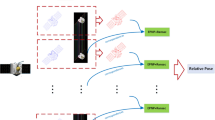Abstract
The occlusion and low-resolution environments lead to insufficient feature data and redundant calculations, which affects the accuracy and timeliness of the unmanned detection system in visual object tracking. To solve this issue, this paper proposes the multi-pose feature generation mapping network for visual object tracking (M-PFGMNet). Firstly, M-PFGMNet suggests a distributed generative adversarial network to increase the accuracy of target detection and reconstruct the local-to-global features of the data with insufficient target features. Secondly, M-PFGMNet proposes a multi-pose feature mapping method for real-time target detection, this method can migrate sample data with high similarity between dynamic target and unmanned system. The experimental results show that the algorithm is effective compared with other similar algorithms in the OTB-50/100 public dataset.




Similar content being viewed by others
References
Cai L, Luo P, Zhou G et al (2019) Dynamic target detection method based on multi-perspective light field reconstruction. International Journal of Distributed Sensor Networks 15(8):1–12
Chang J, Scherer S (2017) Learning representations of emotional speech with deep convolutional generative adversarial networks. In: IEEE International Conference on Acoustics, Speech and Signal Processing (ICASSP), New Orleans, LA , vol 2017, pp 2746–2750
Chen H, Wang Y, Wang G et al (2020) Progressive object transfer detection. IEEE Trans Image Process 29:986–1000
Chen X, Yu J, Kong S et al (2019) Towards Real-Time advancement of underwater visual quality with GAN. IEEE Trans Ind Electron 66 (12):9350–9359
Fan Q, Zhuo W, Tang CK et al (2020) Few-shot Object Detection With attention-RPN and Multi-Relation Detector. In: 2020 IEEE/CVF conference on computer vision and pattern recognition (CVPR), vol 2020. IEEE, pp 4012–4021
Goodfellow IJ, Pouget-Abadie J, Mirza M et al (2014) Generative adversarial nets. In: International conference on neural information processing systems, vol 2014. MIT Press, pp 2672–2680
Hu Q, Zhai L (2019) RGB-D image Multi-Target detection method based on 3D DSF r- CNN. International Journal of Pattern Detection and Artificial Intelligence 33(8):1–15
Huang B, Chen W, Wu X, et al. (2018) High-quality face image generated with conditional boundary equilibrium generative adversarial networks. Pattern Detection Letters 111:72–79
Karbalayghareh A, Qian X, Dougherty ER (2018) Optimal bayesian transfer learning. IEEE Transactions on Signal Processing 66(14):3724–3739
Lu H, Fu X, Liu C et al (2017) Cultivated land information extraction in UAV imagery based on deep convolutional neural network and transfer learning. Journal of Mountain Science 14(4):731–741
Martin D, Gustav H, Fahad SK et al (2015) Learning spatially regularized correlation filters for visual tracking. In: IEEE International conference on computer vision (ICCV), Santiago, vol 2015, pp 4310–4318
Mo K, Li S, Zhang Y et al (2016) Personalizing a Dialogue System with Transfer Reinforcement Learning. In: 32nd AAAI conference on artificial intelligence, vol 2016, pp 5317–5324
Nam H, Han B (2016) Learning Multi-Domain convolutional neural networks for visual tracking. In: IEEE conference on computer vision and pattern detection (CVPR), las vegas, NV, vol 2016, pp 4293–4302
Pan SJ, Yang Q (2010) A survey on transfer learning. IEEE Trans Knowl Data Eng 22(10):1345–1359
Qin F, Xu D, Zhang D et al (2019) Robotic skill learning for precision assembly with microscopic vision and force feedback. IEEE/ASME Transactions on Mechatronics 24(3):1117–1128
Ravishankar H, Sudhakar P, Venkataramani R et al (Sept 2016) Understanding the mechanisms of deep transfer learning for medical images. Deep Learning and Data Labeling for Medical Applications 10008:188–196
Saha B, Gupta S, Phung D et al (2016) Multiple task transfer learning with small sample sizes. Knowl Inf Syst 46(2):315–342
Shi W, Ragunathan R (2020) Point-GNN: Graph Neural Network for 3D Object Detection in a Point Cloud. In: 2020 IEEE/CVF conference on computer vision and pattern recognition (CVPR), vol 2020. IEEE, pp 1708–1716
Sun Y, Liu X, Cong P et al (2018) Digital radiography image denoising using a generative adversarial network. Journal of X-Ray Science and Technology 26(2):1–12
Wu S, Wang S, Laganière R, et al. (2018) Exploiting target data to learn deep convolutional networks for Scene-Adapted human detection. IEEE Trans Image Process 27(3):1418–1432
Yin X, Liu G, Ma X (2020) Fast Scale Estimation Method in Object Tracking. IEEE Access 2020(8):31057–31068
Yuan Z, Li H, Liu J et al (2020) Multiview scene image inpainting based on conditional generative adversarial networks. IEEE Transactions on Intelligent Vehicles 5(2):314–323
Zhang D, Shao J, Hu G et al (2017) Sharp and real image Super-Resolution using generative adversarial network. Neural Information Processing 10636:217–226
Zhao J, Mathieu M, Lecun Y (2016) Energy-based generative adversarial network. In: International conference on learning representations (ICLR), vol 2016, pp 1–17
Zheng X, Ravishankar S, Long Y et al (2018) PWLS-ULTRA: An efficient clustering and Learning-Based approach for Low-Dose 3D CT image reconstruction. IEEE Trans Med Imaging 37(6):1498–1510
Author information
Authors and Affiliations
Corresponding author
Ethics declarations
Competing interests/Competing interests
The authors declared no potential Conflicts of Interests/Competing interests with respect to the research, authorship, and publication of this article.
Additional information
Publisher’s note
Springer Nature remains neutral with regard to jurisdictional claims in published maps and institutional affiliations.
This work was supported by National Key R&D Program of China (2019YFB1311002).
Rights and permissions
About this article
Cite this article
Cai, L., Luo, P., Xu, T. et al. M-PFGMNet: multi-pose feature generation mapping network for visual object tracking. Multimed Tools Appl 81, 38803–38816 (2022). https://doi.org/10.1007/s11042-022-12875-3
Received:
Revised:
Accepted:
Published:
Issue Date:
DOI: https://doi.org/10.1007/s11042-022-12875-3




